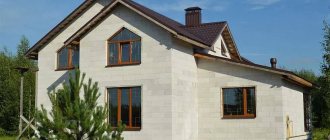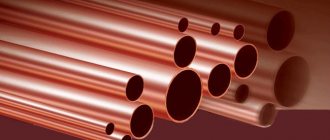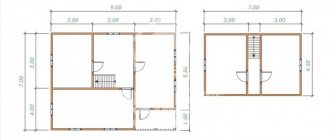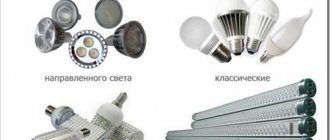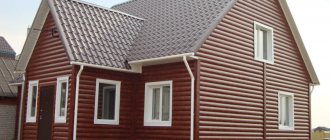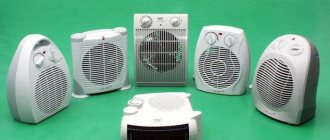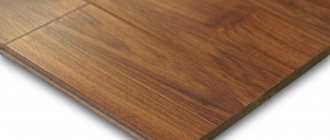The raw material has become in demand due to its excellent thermal conductivity characteristics, low weight, as well as a huge selection of sizes and densities.
Different dimensions of the material are intended for different purposes: they can be used to build walls of houses, basements, cellars or garages. In one case, smaller blocks are applicable, in the other, it is recommended to use only large-format stone.
How is expanded clay concrete made?
Expanded clay concrete is a material that is classified as lightweight concrete. The main difference from concrete is the use of expanded clay as a filler. This material consists of baked clay balls ranging in size from 5 to 40 mm. It is characterized by low weight, porosity, and has sound-proofing and heat-insulating qualities.
The components of expanded clay concrete are
- cement;
- expanded clay;
- sand;
- water.
Production is based on mixing ingredients in certain proportions. First, dry elements are mixed in a hopper, to which water is added. The mixture is brought to a plastic state and poured into molds. They are placed on vibration installations to compact the mixture. After this stage, the resulting blocks are kept in air to gain strength for 28 days.
In production, M400 cement is used, which ensures the production of a material of a given strength. The ratio of components depends on the strength grade; it is determined by regulatory documents. For example, to produce expanded clay concrete grade M250, 400 kg of cement, 720 kg of expanded clay, 640 kg of sand are used per 1 m3 of mixture.
An important characteristic of the material is density, which ranges from 300 to 1700 kg/m3. Elements with a low index are used as insulation. The characteristics of expanded clay concrete blocks depend on the ratio of cement and expanded clay in the concrete mixture. The smaller the first component, the lower the strength of the blocks and the higher the thermal insulation properties.
Important!
The production of expanded clay blocks for house construction is carried out on the basis of technological documentation developed in accordance with the requirements of GOST 33126-2014.
Technical and operational characteristics
- The area of use of expanded clay blocks is determined by the strength they have:
Type Strength value Thermal insulation element 0.05-0.35 t/cm2 Structural and thermal insulation block 0.35-0.1 t/cm2 Constructive 0.1-0.5 t/cm2 - Volumetric mass (volumetric weight) of the building element:
Type Meaning Thermal insulation element 0.35-0.6 kg/cm3 Structural and thermal insulation block 0.6-1.4 kg/cm3 Constructive 1.4-1.8 kg/cm3 - Standard thermal conductivity indicators are 0.14-0.65 W/(m/K). The coefficient depends on the volume of cement and sand in the solution. Hollow bricks have the highest thermal conductivity values;
- Resistance to low temperatures (frost resistance) depends on density and mass - the more an element weighs, the denser it is (there is less air in it), and the greater the number of freezing and thawing cycles it can withstand;
Type Cycles Thermal insulation element 15-50 Structural and thermal insulation block 150 Constructive 500 - Water resistance is set to 10% for standard sizes of expanded clay blocks. To increase this figure, plasticizers and improvers are added to the mixture;
- The greater the porosity of the material, the higher the vapor permeability coefficient. For standard elements it lies in the range of 0.3-0.9 mg/(m/h/Pa);
- Sound insulation properties depend on the degree of porosity and vapor permeability coefficients. The 90 mm thick internal partition blocks sounds up to 50 dB;
- Fire resistance. Expanded clay concrete can easily withstand three-hour exposure to temperatures of 10500C;
- Shrinkage - 0.25-0.55 mm/m;
- The blocks can be used to build multi-storey buildings - up to 12 floors in height.
Pros and cons of expanded clay concrete blocks
Advantages of using expanded clay concrete blocks for building a house:
- strength;
- low thermal conductivity;
- frost resistance;
- fire resistance;
- durability;
- resistance to temperature changes and chemicals;
- environmental Safety;
- small mass of the block, which leads to a reduction in the load on the foundation and a reduction in the cost of its construction;
- speed of execution of work using expanded clay concrete blocks during the construction of a house;
- long service life of buildings;
- low price of blocks, leading to a reduction in the estimated cost of construction;
- ease of installation and finishing of expanded clay block surfaces.
Flaws:
- ability to absorb moisture;
- the need to plaster or finish surfaces with waterproof material;
- the thickness of products for outdoor placement is 20 cm, which is inconvenient from the point of view of determining the thickness of the wall of a house for specific climatic conditions;
- the presence of a large number of masonry joints when laying expanded clay blocks makes it necessary to insulate the facades.
Despite its shortcomings, the material has been used in the construction of low-rise buildings for decades, during which user reviews recommend this material for the construction of load-bearing walls and partitions.
What factors can influence size deviation
Even in the conditions of a well-functioning production process, it is possible that the dimensions of the finished product may deviate from the dimensions prescribed by regulatory documentation. Typical factors influencing the occurrence of marriage are:
1. Physical wear of the walls of the matrix, trays, and pressing equipment. Fresh expanded clay concrete mixture has high abrasive properties. Even high-quality steel, when in contact with it, can wear out by 3-4 mm in 1-2 years, which invariably affects the increase in the dimensions of the finished product. The use of plywood leads to an even faster disruption of the geometry of the forms. Sometimes, under the regular influence of a hydraulic press, the vibrating platform is pushed through.
Mold for expanded clay concrete blocks.
2. Unjustified interference with the design structure of the matrix. Some manufacturers, in an effort to make their products lighter, increase the thickness of the void formers. An increase in the proportion of voids, in addition to a violation of the geometry, also leads to a noticeable deterioration in the strength characteristics of such blocks.
Mold for hollow expanded clay concrete blocks.
Types of expanded clay blocks by purpose
According to their purpose, they are divided into 3 types:
- Structural. The composition of the mixture for their manufacture is distinguished by a large amount of cement component, which gives the blocks strength. Density ranges from 1000 to 1700 kg/m3. Expanded clay blocks for construction can withstand significant loads; they are used in the construction of load-bearing external walls.
- Thermal insulation. They use coarse filler, which has low strength and high thermal insulation. The density of the blocks is from 300 to 900 kg/m3. They are used as insulation in the construction of facades and roofing.
- Structural thermal insulation blocks. With a density from 700 to 1400 kg/m3 they can be used for building enclosing structures and insulating surfaces.
Structurally, blocks are divided into solid and hollow. The former are used for the construction of external walls of a building, the latter have holes, are distinguished by increased insulation parameters, and are used for constructing partitions and insulation.
Advantages
- Standardization of sizes and other indicators allows blocks to be laid using the simplest technology, and the porosity of the material ensures good diffusion of the solution into the body of the element.
- Structures made of hollow blocks can be reinforced with reinforcement. To do this, reinforcement (rods, rods, metal corners) is inserted into the holes in the body of the product, taking on the properties of a reinforcing frame.
- Sufficiently large dimensions of the products allow you to save on mortar and reduce labor costs during the construction of objects of any complexity and number of floors.
- Low weight determines the type of foundation that can be made lightweight and therefore inexpensive.
- An opportunity to save money without additional insulation.
- “Breathing” walls allow you to maintain an optimal indoor climate without condensation.
- Expanded clay concrete surface can be finished with different building materials, and its structure will ensure reliable adhesion of the layers.
- Solid stones can withstand various hanging objects (cabinets, shelves, appliances).
- Minimal shrinkage will practically not affect the finish and integrity of the structures.
Block characteristics
[ads-pc-1] [ads-mob-3]
Dimensions of expanded clay concrete blocks
The sizes of the blocks are regulated by the state standard, depend on the purpose and are equal to:
- for external walls, the typical length can be 30, 40cm, width 30, 20cm, height 20cm;
- for internal walls and partitions, the length is 60, 40, 20 cm, width 9, 12 cm, height 20 cm.
On a note!
The size 40x20x20 cm is most widespread among builders. The dimensions of the blocks are taken into account when designing the structure; they give an understanding of the required amount of material.
A type of gas silicate
Based on their purpose, blocks are conventionally divided into several types:
- Wall. The stone is used for laying outer walls.
- Septal. Brick is used to mount walls inside the building.
Gas silicate blocks of conventional groups differ in size. From a technical point of view, it is advantageous to use smaller sized products for installing partitions in a room. After all, this also saves financial investments.
Gas silicate blocks are produced in the following types according to their shape:
- rectangular, used for laying out load-bearing walls;
- tongue-and-groove - two projections are made on both sides; when connecting between the blocks, a cold bridge is not formed;
- U-shaped, used to make a reinforcing belt at the top of walls and erect lintels.
In addition, manufacturers produce blocks of arbitrary shape, with special handles for gripping.
Expanded clay blocks for building a house – which ones are better?
To determine which expanded clay blocks are best used for building a house, you should first pay attention to the manufacturer. Producing blocks in artisanal conditions does not allow one to accurately observe the dosage of ingredients for preparing the mixture, to qualitatively mix and compact the components, and to bring the finished material to the required strength. Such blocks will have the lowest price on the market.
High-quality material will allow you to build a house, following construction technology, and ensure its long-term operation without repairs. Quality must be confirmed by the presence of a batch of goods with a certificate of compliance with the requirements of regulatory documents, which serves as proof of compliance with the manufacturing technology.
Compared to other building materials
Gas and foam blocks have less weight, but the former categorically do not tolerate moisture, unlike expanded clay blocks. The average size for foam block construction is 60x30x20 cm. This material is less durable, although otherwise the properties of all three are largely similar. They allow owners to save decent amounts of money on construction. However, expanded clay block, when properly processed, is suitable for multi-story buildings, and its thermal insulation properties are much higher.
The gas block has the ability to “shrink” over time, so its finishing may take longer. It is not recommended to build a building higher than three floors from foam blocks: the material is not strong enough. In addition, it is not so easy to find it of proper quality.
Wood is an even more environmentally friendly material that can be easily processed. But its negative feature is the possibility of fire and the negative effects of moisture. With frequent temperature changes, wood deteriorates and requires maintenance. It is coated with a special composition. In addition, insects can live in wooden floors.
There is another fireproof and durable material - brick, but its disadvantage is considered to be large weight and small size. Expanded clay concrete will save more money, since fewer blocks will be required, and the construction process will not be so long.
Features of choosing expanded clay concrete blocks
When choosing expanded clay concrete blocks, experts recommend paying attention to the following points:
- identical geometric dimensions of the product batch;
- no chips or cracks;
- dark gray color guarantees product quality.
Photos of the built houses characterize them as reliable, durable and durable objects. To get a good result, it is recommended to carefully choose the manufacturer of the material. The quality of the blocks can guarantee long-term operation of the house.
Flaws
Any building material can have its flaws. The standard sizes of expanded clay blocks will not allow you to show your creative imagination in full force. The parts are quite large, and redevelopment will be very problematic. Another disadvantage is that most of these houses are built according to a monotonous plan. As a result, buildings are devoid of individuality, and the possibilities of designers and owners are limited. The only way to show originality is to use unusual exterior finishes.
Another disadvantage is that it is somewhat difficult to process. Unevenness and chips may form on the blocks. Therefore, cutting can only be done using a special tool - a power saw. Hollow blocks are not strong enough and need to be strengthened or used for floors.
Material life
Expanded clay concrete blocks belong to the category of durable materials. Manufacturers claim that the service life of their products varies between 50-100 years. It should be clarified that there is no exact data on the service life of expanded clay concrete blocks. Therefore, the manufacturer's data can be questioned.
However, according to the results of laboratory tests, wall blocks are designed for 50 freezing cycles. For most regions of Russia, one such cycle is equal to a calendar year, so we can assume that 50 years is the guaranteed service life of an expanded clay concrete block.
Load-bearing wall thickness
The construction of any object is preceded by strength calculations. It is not always possible to perform such actions on your own; for this reason, it is allowed to use parameters that determine strength.
The thickness of the load-bearing wall is determined taking into account these data.
Another important factor is the purpose of the facility being built. If the house is low-rise and is intended to be used during the summer season, it is recommended to comply with a number of simple requirements:
- when constructing a one-story building in an area with a warm climate, a garage and other outbuildings, aerated concrete 250 mm thick is used;
- for two- or three-story buildings this parameter increases to 300 mm;
- when constructing basements or ground floors, the recommended wall thickness is from 30 to 40 cm. But remember that aerated concrete is afraid of abundant moisture, so it is necessary to use other materials.
If the construction of a facility intended for year-round living is meant, the strength indicator is not enough. In this case, the thermal conductivity of the material is taken into account. Using calculations, the minimum thickness of an aerated concrete wall is determined, or the same parameters remain as for summer houses, but the external walls are additionally insulated. In this case, the calculation is carried out according to the available money - a more profitable option is determined. Either the thickness of the load-bearing aerated concrete wall is increased, or insulation is used.
When determining the cost of insulation material, do not forget about fasteners and the cost of specialist services.
Secrets of economical spending
If you follow some expert advice, the use of adhesive when laying aerated concrete will be more economical.
The use of special tools speeds up the construction process and minimizes the use of glue, and, accordingly, reduces the cost of work. It is recommended to use a ladle, a rubber hammer, a square, a grater with sandpaper, and a saw for masonry.
The glue should be applied with a spatula or a special spatula. Then the composition will apply more evenly and it will be possible to minimize its consumption. Before laying, the blocks must be cleaned of dirt. It is important to dry them well so that they are not wet.
Quantity calculation
Building a house, basement, country house or other structures with your own hands is a troublesome and financially costly undertaking. To save your budget, you need to prepare an estimate in advance and calculate the required number of blocks.
Thanks to correct calculations, it is possible to reduce the risks of wasting money on purchasing excess material.
To calculate the required number of blocks, you need to take measurements. Algorithm of actions:
- calculating the perimeter of a structure (the easiest way is to calculate the sum of all sides of the rectangle);
- the resulting value must be divided by the length of 1 module - this way the number of blocks required to build 1 row is determined;
- to calculate the total number of rows, divide the height of the building by the height of the block;
- to find out the required number of blocks, you need to multiply the values obtained in steps 2 and 3.
In this case, it is not worth taking a supply of building materials, since the calculations did not take into account the presence of window and door openings. You can also use online calculators to calculate the number of blocks.
Since the blocks are stored on pallets, you also need to calculate their number in the pallet. The number will depend on the area of the pallet, the weight of the building material and its dimensions. For example, if 60 expanded clay blocks are laid on a pallet, you need to divide the required number of blocks by this value.
Manufacturers
Many domestic factories are engaged in the production of various types of expanded clay blocks. Let's list the most popular ones.
- Kstovo expanded clay concrete plant. Produces modules using expanded clay fraction 5-10 mm. The material is manufactured on the Rifey-Polyus automated line. The company produces solid and four-slot blocks.
- "Teplostroy IM" The company was founded in Cheboksary. It has been producing expanded clay concrete modules since 2005. Productivity is 1500 blocks per day. For the production of building materials, the company purchases expanded clay 10-20 mm, which is subsequently crushed into smaller fractions - 5-7 mm.
- Ishleysky building materials plant. One of the first producers of expanded clay blocks in Chuvashia. The company was founded in 2000. In the first years of operation, modules were manufactured using homemade equipment. Today, the Rifey-Universal automatic line is used for their production. The daily production capacity of the plant is 1200 products.
- Bloks 21. The company produces hollow expanded clay blocks in Novocheboksarsk. Maximum productivity reaches 1500 products per day. Bloks 21 company offers its customers delivery and unloading.
- "EcoBlock". Manufacturer of large format blocks. The plant is located on the territory of Naberezhnye Chelny. Offers modules of non-standard sizes, as well as decorative solutions for cladding work. The company produces sand-free blocks. Expanded clay, cement and water are used to prepare the solution.
Popular manufacturers of block expanded clay materials also include PF Veles, GK Mercury, and Forward.
